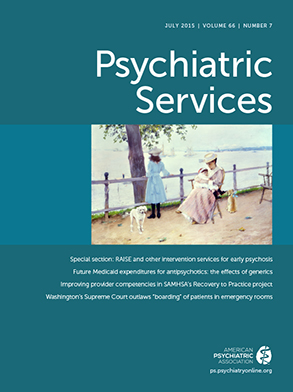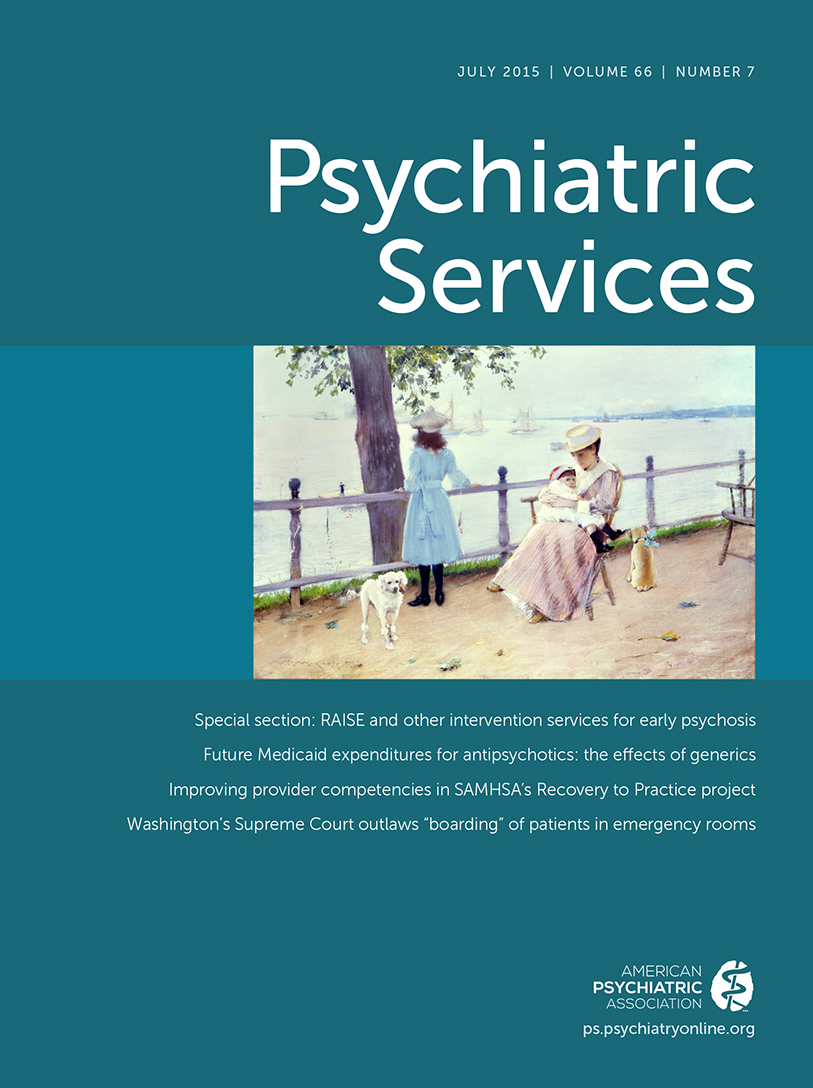The NAVIGATE Program for First-Episode Psychosis: Rationale, Overview, and Description of Psychosocial Components
Abstract
Treatment Programs for First-Episode Psychosis
The NAVIGATE Program
Target Population and Setting
The NAVIGATE Treatment Team
NAVIGATE Team-Based Activities
Treatment Planning, Review, and Discharge
NAVIGATE Manuals
Conceptual Foundations of the NAVIGATE Program
Core Skills of NAVIGATE Team Members
| Skill area and goals | Key elements |
|---|---|
| Shared decision-making skills | |
| Facilitate active engagement in treatment | Information provided about treatment options and likely consequences |
| Establish and maintain good working alliance between client and team members | Client preferences elicited and respected |
| Support self-determination and personal autonomy | Treatment decisions negotiated and made jointly; family members involved (with client permission) |
| Strengths and resiliency focus | |
| Improve positive feelings and self-esteem | Identify personal qualities, knowledge, skills, and resources |
| Instill hope for the future | Draw attention to strengths and consider how to capitalize on them to achieve goals |
| Promote use of all available resources for achieving goals | Explore how person coped with and bounced back from previous challenges |
| Help person move forward in life after disruption of psychotic episode and any persistent difficulties | Build upon and enhance skills for dealing with stress and rebounding from setbacks |
| Motivational enhancement | |
| Increase effort to work on personal goals | Empathic listening |
| Enhance desire to improve illness management | Elicit goals and support self-efficacy for achieving them |
| Resolve ambivalence about behavior change | Explore how improved illness management could help achieve goals |
| Help find a sense of purpose in one’s life | Instill hope for achieving goals |
| Psychoeducational skills | |
| Provide important information to enable shared decision making | Provide information in different formats (for example, handouts, discussion, and whiteboard) |
| Ensure relevant information is understood and retained | Break up information into small “chunks” |
| Facilitate ability to access and use information when needed | Interactive teaching and discussion format, with frequent breaks to ask and answer questions, check understanding, and explore person’s experience |
| Help individual learn practical facts about illness and its treatment | Adapt language, special terms (for example, diagnosis), and amount of detail to the individual; seek common ground when there are disagreements about topics such as symptoms and diagnosis |
| Collaboration with natural supports | |
| Enlist family support for client goals and participating in treatment; improve monitoring of client’s disorder; and reduce stress in the family | Broad definition of “family” based on client’s wishes; outreach to engage family members; provide information to family about illness and treatment similar to that in the standard work on IRT; elicit and respond to family members’ questions and concerns; avoid judgment; express empathy about challenging experiences and focus on resiliency; ensure that treatment team members are accessible to family; responsive to family requests for help |
Shared Decision Making
Strengths and Resiliency Focus
Motivational Enhancement Skills
Psychoeducational Skills
Collaboration With Natural Supports
Treatment Interventions Provided in the NAVIGATE Program
| Intervention | Provider | Goals | Description |
|---|---|---|---|
| Individualized medication management | Prescriber | Reduce symptoms; minimize side effects and adverse medical health outcomes | Provided to all clients; regular monitoring of symptoms, treatment adherence, and side effects by using standardized questions during regular office visits; continuous monitoring of risk factors for metabolic and cardiovascular disease; guideline-based pharmacological treatment emphasizing low doses; close coordination with primary care provider and referral for medical services, when appropriate; encourage healthy lifestyles, which can include coordination with the IRT clinician on lifestyle changes |
| Family education program | Director (typically) | Establish collaborative relationships between family and treatment team; instill hope for recovery from psychosis; teach family about psychosis and its treatment; strengthen communication; reduce family stress; improve family support for client’s goals and participation in treatment; prevent relapses | Offered to all families, with client consent; holding an individual session with each significant other and the client to get to know them, hear their experience, and get their point of view; family education (10–12 sessions; offered to all families; education about psychosis, treatment, and stress reduction; development of relapse prevention plan; emphasis on family resiliency and strengths); monthly check-ins (brief monthly in-person or phone contact to review progress and identify family concerns or clinical issues; conducted following completion of family education); family consultation (1 or 2 sessions per problem as needed; addresses specific problem identified by family; focused problem-solving approach used by family clinician; specific solutions identified, action plan formulated, and follow-up conducted); modified intensive skills training (8–12 sessions if needed after basic family education completed; targets persistently high levels of family stress; intensive skills-training methods used to teach communication and problem-solving skills) |
| Individual resiliency training (IRT) | IRT clinician | Help client achieve personal recovery goals; educate about psychosis and its treatment; process experience of the psychotic episode; improve illness self-management, including relapse prevention and coping; reduce substance abuse; increase social support and quality of relationships; increase resiliency and well-being; improve health | Psychotherapeutic interventions based on cognitive-behavioral therapy and motivational interviewing offered to all clients; individual sessions conducted weekly or biweekly for as long as needed; goal setting and tracking throughout the program; educational and skills curriculum organized into different topic areas (or modules), with handouts and clinician guides for each module; standard modules recommended for all clients; individualized modules provided as needed or when desired; flexibility in which modules to cover, when, and in what depth; information, strategies, and skills taught using motivational, psychoeducational, and cognitive-behavioral methods; home assignments collaboratively set and followed up each session |
| Supported employment and education (SEE) | SEE specialist | Obtain and keep competitive employment; enroll in mainstream education programs and obtain desired degrees | Offered to all clients; specific work and school goals developed based on client’s preferences; prevocational training not required; rapid job or school search following identification of client’s goals; most services provided in the community not the clinic; practical assistance in finding jobs or enrolling in school programs, including interacting with employers or school personnel; respect for client’s decision about disclosure of psychiatric disorder to employers or school personnel; follow-along supports after client gets a job or enrolls in school in order to facilitate job retention, school degree completion, or transition to another job or school |
Individualized Medication Treatment
Family Education Program
Individual Resiliency Training
| Module | Description | N of sessions |
|---|---|---|
| Standard module | ||
| Orientation | Overview of IRT program, providing treatment expectations, description of all modules, and teaching and practice of breathing-retraining skill for anxiety reduction | 1 or 2 |
| Assessment and goal setting | Evaluation and discussion of clients’ character strengths and areas of life satisfaction and dissatisfaction in order to create specific short- and long-term personally meaningful goals | 2–4 |
| Education about psychosis | Didactics and discussion about the stress-vulnerability model and various aspects of psychosis, including dispelling myths to destigmatize mental illness | 7–11 |
| Relapse prevention planning | Discussion of triggers and warning signs and development of personalized plan for preventing relapse and rehospitalization | 2–4 |
| Processing the psychotic episode | Development of cohesive narrative of episode, narrative exposure-based processing of traumatic reactions, and targeted cognitive restructuring for self-stigmatizing beliefs | 3–5 |
| Developing resiliency | Positive psychology exercises to enhance resilient qualities, increase positive emotions, and build skills for using particular strengths in daily life | 3 or 4 |
| Building a bridge to your goals | Progress and goal review, discussion of possible use of individualized modules with plan for continuation or termination | 2 or 3 |
| Individualized module | ||
| Dealing with negative feelings | Cognitive restructuring for coping with psychotic, posttraumatic, mood, and anxiety symptoms | 7–12 |
| Coping with symptoms | Behavioral coping strategy enhancement for psychotic symptoms, mood, and anxiety symptoms | 2 per symptom |
| Substance use | Assessment of substance use and interference of substances combined with motivational interviewing approach to develop cognitive and behavioral strategies to reduce substance use | 11–20 |
| Having fun and developing good relationships | Based on social skills training to increase pleasurable activities and adaptive interpersonal communications | 3–27 |
| Making choices about smoking | Motivational interviewing approach coupled with behavioral and cognitive coping strategies to help with decision making and next steps about smoking cessation | 2–4 |
| Nutrition and exercise | Education about weight gain and psychosis, including metabolic syndrome, plus behavioral strategies for improving general medical health | 2–4 |
Supported Employment and Education
Conclusions
Acknowledgments
References
Information & Authors
Information
Published In

Cover: Gravesend Bay, by William Merritt Chase, 1888. Private Collection. Photo credit: Art Resource, New York City.
History
Authors
Funding Information
Metrics & Citations
Metrics
Citations
Export Citations
If you have the appropriate software installed, you can download article citation data to the citation manager of your choice. Simply select your manager software from the list below and click Download.
For more information or tips please see 'Downloading to a citation manager' in the Help menu.
View Options
View options
PDF/EPUB
View PDF/EPUBLogin options
Already a subscriber? Access your subscription through your login credentials or your institution for full access to this article.
Personal login Institutional Login Open Athens loginNot a subscriber?
PsychiatryOnline subscription options offer access to the DSM-5-TR® library, books, journals, CME, and patient resources. This all-in-one virtual library provides psychiatrists and mental health professionals with key resources for diagnosis, treatment, research, and professional development.
Need more help? PsychiatryOnline Customer Service may be reached by emailing [email protected] or by calling 800-368-5777 (in the U.S.) or 703-907-7322 (outside the U.S.).
